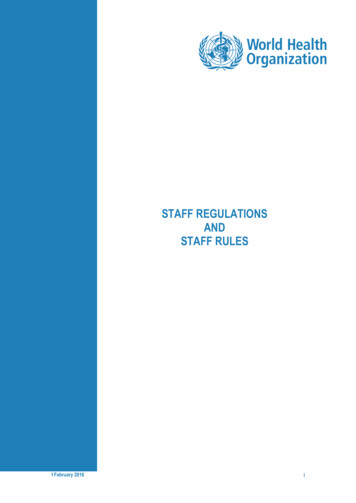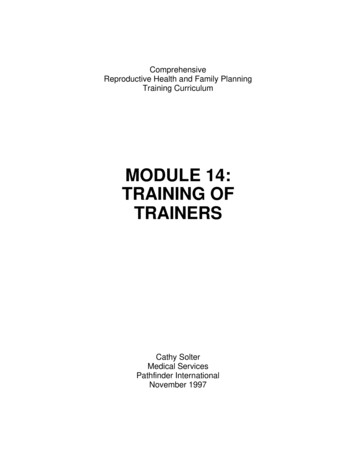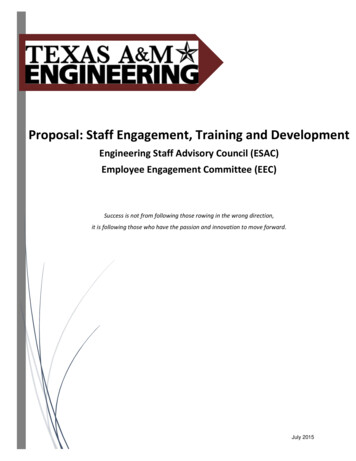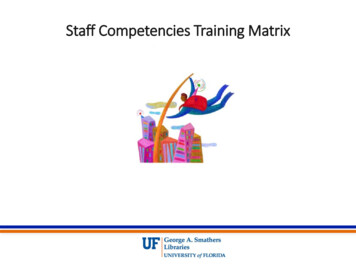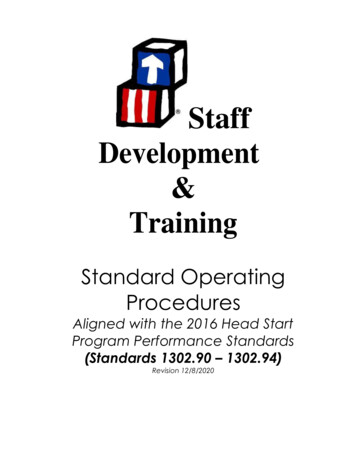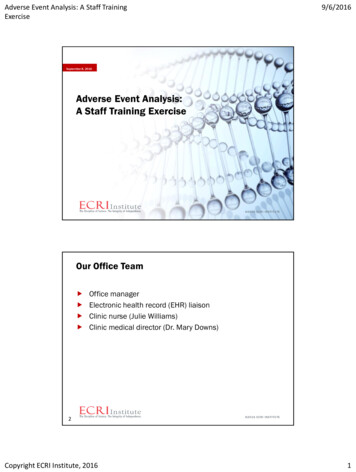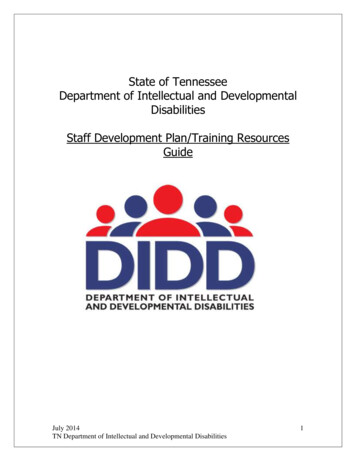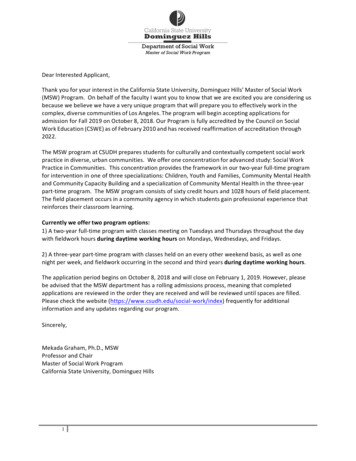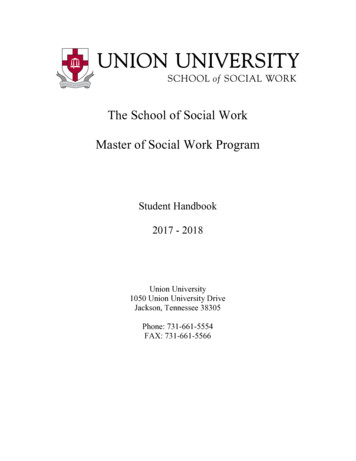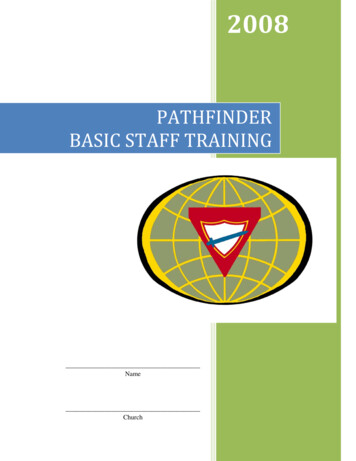
Transcription
2008PATHFINDERBASIC STAFF TRAININGNameChurch
Pathfinder Basic Staff TrainingTable of ContentsSection 1- History, Philosophy and Purpose of the Pathfinder Club . 3Section 2 – Understanding Pathfinders . 4Punishable Offenses . 9Discipline Procedures . 9Section 3 – Club Leadership . 11Section 4 CLUB ORGANISATION . 16Section 5- Planning and Programming . 18Section 6 – Teaching the Pathfinder Curriculum. 21Section 7 Camping and Outdoor Education. 23Section 8 – Drills and Ceremonies. 29Congratulations . 30 Table of Contents 2
Pathfinder Basic Staff TrainingSection 1 History, Philosophy and Purpose of the Pathfinder Club Section 1- History, Philosophy and Purpose of the Pathfinder Club 3
Pathfinder Basic Staff TrainingSection 2 – Understanding PathfindersObjectiveTo develop an understanding of the developmental needs of the Pathfinder-age young peopleand how to relate them effectivelySession Outliney Developmental Characterises of Pathfindersy Basic principles of Effective Club DisciplineDevelopmental Characterises of Pathfindery Pre-Adolescence .(9-12 yrs)y Early Adolescence .(13-15 yrs)y Middle Adolescence .(16-17 yrs)In Each Category we will look aty General,y Metal,y Physical,y Social andy Spiritual CharacterisesPre AdolescenceFull of noise and ceaseless activityGeneralGirls at the age are physically, mentally and more emotional than boys.Growing tendencies of independences and self-assertionQuick to learn and have memory recallHave heroes.Lively interest in religionThey find it natural to turn to God and commit them self.Golden Age memoryMetalAlert and eager to investigate and learnLove stories and good booksThey are collectors (90% of children that age collect one thing or other)Age not for specialisationThe healthiest period of lifePhysicalBody and mind are well balanced for co-ordinationRestlessness“there never seems to be any nice, relaxed, middle ground in a child’sbehaviour. He is either running at a wild clip or stopped dead – and bothstrike fear in the breast of a parent”Secret codes and adventureSocialLearning teamwork but still retain independent spiritVivid imaginationGreat hero worshipNo interest in the opposite sexBoys prefer to be by themselves Section 2 – Understanding Pathfinders 4
Pathfinder Basic Staff TrainingSpiritualGirls choose their own groupHave key interest in spirituality and the work of the churchPeek age of baptism (12)Like witnessing activates, delights in award badges, ribbons etcEasy to instruct in religion.Early d growthAwkwardness due to lack of co-ordination of body and mindEmbarrassmentThe Ugly Ducklings SyndromeBelonging to Peer GroupInterest in the opposite sex accompanied by bashfulnessCritical rather than credulousDay dreamersReligion interest continues and becomes a matter of experienceAlert Subject to day-dreamingLearns quicklyBoys have key interest in scientific data and girls become more interested inhomemakingThe health is excellent second only to pre-adolescent periodRapid physical growth., with tremendous appetite accompanying the growth.Muscle development – causing awkwardness and clumsinessSex organs begin to developOn average girls taller then boys at 12 and 13 slightly taller at 14 les at 15 and2 inches shorter at 16Loyalty to peersFreedom seekersMoney making schemes dropping out of schoolMood swingsStrong likes and dislikes of foodGreat love for athleticsCrude sense of humourAttraction of the opposite sexInterest in spiritual things wanes at this age13 at his age is the 2nd largest number of youth baptismCareer choiceLess tendency for this group to demonstrate their feelings on spiritual mattersConflict with conscienceMiddle AdolescenceGeneralRapid growth for males reaching full heightDeveloped into their own individualYoung adult in their own right Section 2 – Understanding Pathfinders 5
Pathfinder Basic Staff TrainingMetalPhysicalSocialSpiritualQuestion everything and want proofHave great respect for “scholarship”Making of definite planSexual Development85% fully developed into adulthoodMuscles are developed and they enjoy physical fitnessCliques and what to be surrounded by special friendsCritical and frank in expression of othersSensitive and guided by public opinionEither goes forward or loses interestBasic Principles of Effective Club DisciplineMorale, or club spirit, is the tangible element that determines the success of any pathfinderClub. It the result of a combination of a variety of important factors. All pathfinder membersand staff need to work together on developing a sense of unity and belonging, andmaintaining interest and enthusiasmClub staff needs to check for the following:1. S O2. A3. H c4. R t d5. U C ’s Table6. Making Members W7. P Friends T8. Reviewing the C Work9. Planning a b P10. Developing Unit C11. Pathfinder M p12. E13. C E14. T MGuild lines for Balance Discipley Establish Rules and regulation and a point system.y Inform the Pathfinders of the rules, your expectation and methods of enforcements Section 2 – Understanding Pathfinders 6
Pathfinder Basic Staff Trainingy “Rules should be few and well considered, and when once made, they should beenforced. Whether is found impossible to change, the minds learns to recognise andadapt itself to” (Education pge 290)y Present devotional admonition on disciple, explaining the Pledge and the Lawy Present devotional on discipline, explaining the Pledge and Law.y Consistently and diligently apply training discipline.y Counsel with guilty youth before disciplinary action, and pray with them.y When they understand, they normally cooperate.Prevention of Discipline Problem1. Plan an e program of a .2. Never go to m u .3. Be f , caring, and a at all times.4. Cultivate a s of h5. Don’t use s or .6. Don’t be a “f ”.7. Be f and i –don’t have favorites.8. Show s -c and be p , even under pressure.9. Watch the use of your v –speak clearly and with a , butdon’t s !10. Give c , p instructions and c .11. Watch m that could lead to r , and avoids and colloquialisms.Method of DisciplineDOy P Cy Use G Jy Take care of I Dy E if necessaryDON’Ty P in Ay Use t and w that can’t be carried out.y Force a Public Section 2 – Understanding Pathfinders 7
Pathfinder Basic Staff Trainingy D after club meetingy A extra tasky “Dunce-Cap” Discipliney Use c P Section 2 – Understanding Pathfinders 8
Pathfinder Basic Staff TrainingPunishable OffensesCases of clear and unjustifiable insubordination.Cases where tendencies and activities are considered serious offenses, or behaviour problems,such as: Indecency Impudence to counsellor Offensive language Injuring property Cheating and stealingDiscipline Procedures1. If a Pathfinder is not obedient and cooperative: The counsellor should tactfully speak to the Pathfinder. The counsellor should explain what is expected of the Pathfinder as a member ofthe club. The counsellor should have a private visit and pray with the Pathfinder.2. If the Pathfinder continues to be disobedient and uncooperative the counsellor shouldsolicit the help of the deputy director in charge of club discipline. They will privately counsel together with the Pathfinder. They should earnestly solicit cooperation. They should pray with him.3. If it should be necessary to approach the Pathfinder on a third occasion, thecounsellor, deputy director, and director should meet with the Pathfinder privately. Counsel with the Pathfinder and explain how important it is to have unity,cooperation, and an understanding spirit among club members. Attempt to convey to him the seriousness of the matter in the light of him notdoing his “honest part.” Prayer together. Make an appointment to visit the home and counsel with the parents and thePathfinder together.4. If, after this round of counsel and a visit to the home, the Pathfinder proceeds to bedisobedient and uncooperative, the counsellor should have a private visit and prayerwith the Pathfinder.5. If misbehaviour continues the counsellor, deputy director, director and Pathfindershould have another meeting together. The case will be referred to the disciplinary committee for further study. Disciplinary committee consists of the director, deputy directors, the counsellor ofthe Pathfinder, and a Pathfinder boy and girl chosen from the club. The Pathfinder’s parents should be notified, and the Pathfinder wills be given aone-month vacation from the club. Punishable Offenses 9
Pathfinder Basic Staff Training He should be visited at his home by the counsellor during the period of hisabsence. Discipline Procedures 10
Pathfinder Basic Staff TrainingSection 3 – Club LeadershipAttributes And Qualities Of Christian Leaders Involving In PathfinderingQualities of a Pathfinder Leadera) Live a C -C Lifeb) Love b and gc) Be o and ed) Has a v (knows WHY they’re involved)e) Has a m (knows HOW they’re doingf) Be a m of his/her own eg) Enjoy the o of dh) Maintain p r with fellow workersi) Have a c personalityj) Have a s of Hk) Be r and cl) Enlist cm) Be able to delegate r and an) Has i (keeps commitments)o) Understand the C of Junior Youthp) Master D skillsq) Know how to o Section 3 – Club Leadership 11
Pathfinder Basic Staff TrainingFive Styles Of Leadership And When They Are Appropriate To PathfinderMinistryDefinition of Leadership“Leadership is Influence. Leadership means you have people who follow youotherwise you’re just out taking a walk” John C. MaxwellPerson centeredGroup aireTELLSSELLSTESTSCONSULTSJOINSAuthoritative (Autocratic) Leader– Motivation is produced by creating a structured set of rewards and punishments.AdvantagesDisadvantagesEvaluative Section 3 – Club Leadership 12
Pathfinder Basic Staff TrainingBureaucratic (Political) Leader– Police officer -- He or she enforces the rules.AdvantagesDisadvantagesDemocratic (Participative) Leadership– The “coach” leader has the final say, but gathers information from staffmembers before making a decision.AdvantagesDisadvantagesLaissez faire LeadershipAll authority or power is given to the staff (& Pathfinders) and they must determinegoals, make decisions, and resolve problems on their own. Section 3 – Club Leadership 13
Pathfinder Basic Staff TrainingAdvantagesDisadvantagesVarious Leadership Roles And Function And Their ApplicationsBuilding FunctionsEncouragerFriendly, warm, responsive. Accepts othersand their contributions. Gives other peopleopportunities or recognition.Feelings ExpresserAsk for opinions to see if group is ready tomake a decisionHarmonizerAttempts to reconcile disagreements andreduce tensions. Get people to explore theirdifferencesCompromiserGoes along with group decision and acceptsthe ideas of others. Act as an interestedaudience.Gate-KeeperKeep Channel of communication openFacilitate participation of others. EncoringsharingStandard SetterSends and expresses feelings of group.Calls attention to reactions of group to ideasand suggestions. Share feelings and howthey affect members.Consensus – TesterState standards for group to achieve andapplies standards for evaluation andproductions.FollowerWhen necessary explain any item notclearly heard. Hears and solicits feedback.Yielding and admits to error Maintaincohesion in groupsListener Section 3 – Club Leadership 14
Pathfinder Basic Staff TrainingTask FunctionsInitiatorAsks for expression or feelings. Seeks ideas andsuggestions. Solicits expression of valueInformation seekerGathers facts relevant to group. Seek organisation offacts.Information GiverGives examples and develops meanings. Makesgeneralisations and indicates how proposals maywork out.Opinion SeekerInterprets ideas or suggestions. Define terms andclears up any confusion. Indicate alternatives andissues before group. Listen and preserves. Optionseeker.Opinion GiverOffers facts and information relevant to groupsClarifier
Pathfinder together. 4. If, after this round of counsel and a visit to the home, the Pathfinder proceeds to be disobedient and uncooperative, the counsellor should have a private visit and prayer with the Pathfinder. 5. If misbehaviour continues the counsellor, deputy director, director and Pathfinder should have another meeting together.
